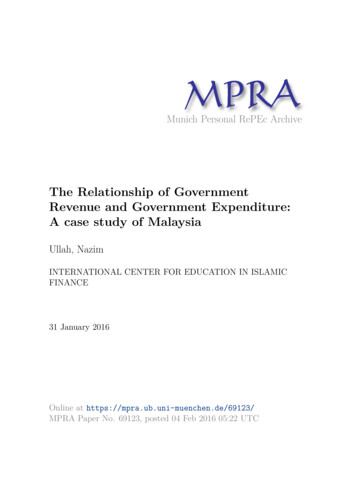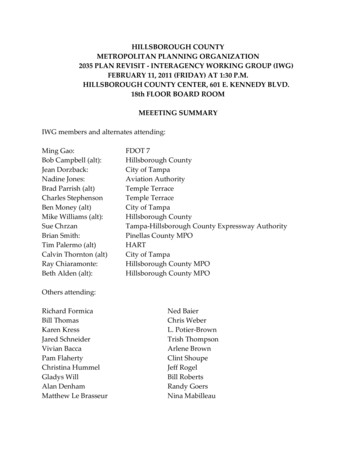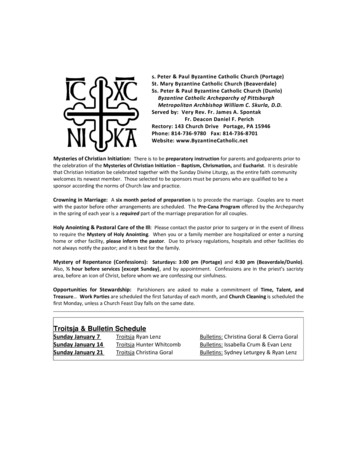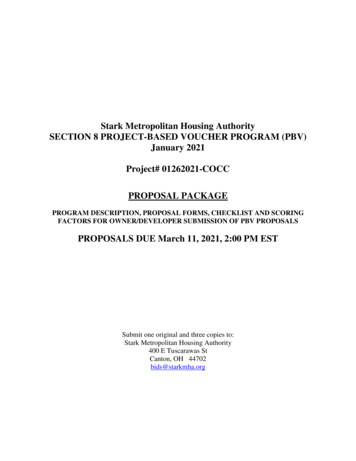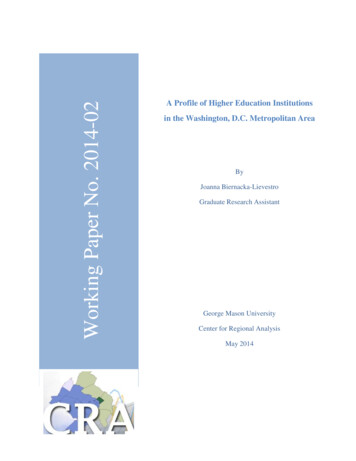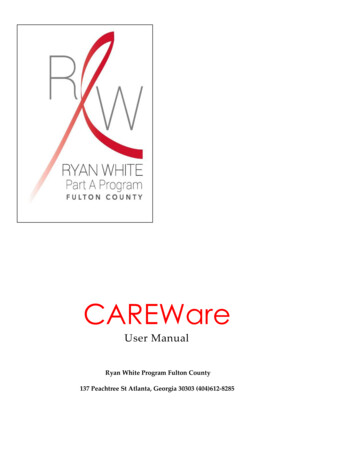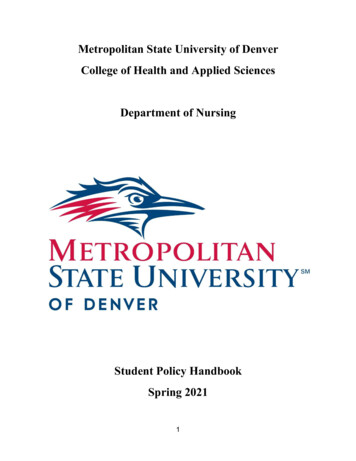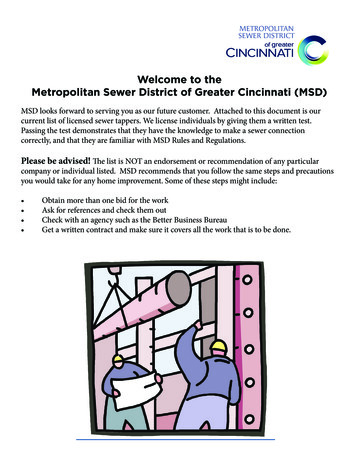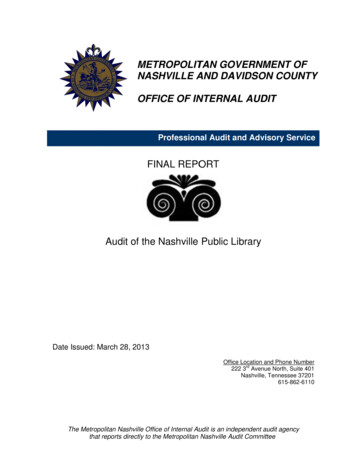
Transcription
METROPOLITAN GOVERNMENT OFNASHVILLE AND DAVIDSON COUNTYOFFICE OF INTERNAL AUDITProfessional Audit and Advisory ServiceFINAL REPORTAudit of the Nashville PPublicublic LibraryDate Issued: March 28,, 2013Officeffice Location and Phone Number222 3rd Avenue North, Suite 401Nashville, Tennessee 37201615-862862-6110The Metropolitan Nashville Office of Internal Audit is an independent audit agencythat reports directly to the Metropolitan Nashville Audit Committee
EXECUTIVE SUMMARYMarch 28, 2013Results in BriefFiscal Data and RecommendationsAn audit of the Nashville Public Library wasperformed. Key objectives and conclusionswere as follows: FY 2012Operating ExpenseFour Percent FundsFY 2011Operating ExpenseFour Percent FundsWere revenue receipts received at theNashville Public Library real, complete,and accurately recorded in bank andaccounting records?Yes. No material discrepancies werefound. Actual 20,109,6761,941,303 19,695,0004,210,403 19,406,1222,209,323Recommendations Leverage the Millennium system to developa methodology for tracking, monitoring, andquantifying items missing from the library’scollection.Yes. No material discrepancies werefound. Were expenditures aligned with theservice delivery objectives of theNashville Public Library?Develop a policy defining at what specificlength of time an item should be missingbefore it is classified as lost/stolen. Develop a report to be distributed toappropriate levels of management detailingthe current number of missing items and theincrease or decrease over time. Segregate cash receipt functions within theconference room section.Were payroll expenditures for servicesperformed or benefits earned at theapproved rate of compensation?Yes. No material discrepancies werefound. Budget 19,901,1004,001,080Were library collections properlysecured?Yes. No material discrepancies werefound. How do per capita measures andstatistical information such ascirculation, patron visits, types ofexpenditures, sources of revenue flowscompare to public libraries in similarjurisdictions?Comparable governmental jurisdictionsspend more money for library servicesthan the Nashville Public Library, over 7 million or 30 percent more. However,Nashville Public Library programattendance and e-circulations exceededthis group. Printed material circulation,CD/DVD circulation, and referenceassistance were behind peerjurisdictions by approximately one half. 11National Public Library Association 2011 Statistical ReportAudit of the Nashville Public Libraryii
Table of ContentsINTRODUCTION.1Audit Initiation.1Background .1Organizational Structure .1Information Systems .2Financial Information.2OBJECTIVES AND CONCLUSIONS.5OBSERVATIONS AND RECOMMENDATIONS.10A – Enhance Controls Over Security of Collection Inventory .10B – Lack of Segregation of Functions .11GENERAL AUDIT INFORMATION .13Statement of Compliance with GAGAS.13Scope and Methodology .13Criteria.13Audit Staff.13APPENDIX A. ORGANIZATION CHART.14APPENDIX B. MANAGEMENT RESPONSES .15Audit of the Nashville Public Libraryiii
INTRODUCTIONAudit InitiationThe audit of the Nashville Public Library was conducted as part of theapproved 2012 Audit Work Plan. The audit was initiated based on thenumber of years elapsed since the last audit was conducted in 2007.BackgroundThe mission of the Nashville Public Library is to “provide information,programs, and reference assistance to individuals, families, and thelarger community so they can enjoy the benefits of reading and life-longlearning”.The library carries out this mission and enhances the quality of life forits citizenry through 20 library branches, the Main Library and theArchives. In fiscal years 2011 and 2012, over 8.5 million librarymaterials were checked out and over 7.6 million patron visits wereestimated for the Nashville Public Library system. The library alsoserved patrons with reference material, online access, access tonumerous databases, computer training classes and other programs.OrganizationalStructureThe Nashville Public Library has seven distinct lines of business whichare as follows:Reference Information: The purpose of the Reference Informationfunction is to provide reference assistance and online informationproducts.Library Materials: Provides circulating, research and reader’s advisoryproducts to individuals and the larger community.Equal Access: This program provides materials, information andaccessibility products to people involved with or experiencing problemswith or loss of vision or hearing or having physical disabilities.Education and Outreach: Provides educational opportunities, culturalevents and public information products to the Nashville Community.Town Square: Provides community gathering and technical assistanceproducts to individuals and groups so that they can have a public placeto come together.Library Customer Technical Support: This program provides technicalsupport products to library customers so they can enjoy reliableautomated library service.Administration: Provides administrative services products to supportlibrary operations so it can deliver results for customers.Audit of the Nashville Public Library1
InformationSystemsFinancialInformationSignificant information systems used at the Nashville Public Library areMillennium, EnterpriseOne, and Collection Analytical Software. Millennium is an integrated library software system utilized by theNashville Public Library as well as many other jurisdictions to recordpatron, collection, and circulation information. The system is alsoused to record all cash receipts. EnterpriseOne is used to account for all expenditures, revenuedeposits, payroll and time keeping for the Nashville Public Library. Collection Analytical Software is used by the Nashville PublicLibrary to help determine the needs of the library with respect to thevarious collections of printed material, e-books, music, etc.The Nashville Public Library receives the majority of their funding fromMetro Nashville’s general fund. In addition, the agencies receive someMetro Nashville four percent reserve funding, various grants, andsupport from the Nashville Public Library Foundation, a local nonprofitentity.Budget InformationA review of the 2013 Citizens Guide to the Metro Budget was conductedand ascertained the following regarding the libraries business lines.Exhibit A – Budgeted Dollars per Line of BusinessBudget201320122011 8,980,413 8,421,612 Reference InformationEducation 84,2121,960,311Equal AccessLibrary CustomerTechnical own Square242,100216,376239,400 22,848,052 21,781,924 21,353,944Library MaterialsTotalSource: Metro Nashville’s EnterpriseOne Financial SystemPayroll ExpendituresThe library had 325 budgeted positions in fiscal year 2011 and 331 infiscal year 2012. Per EnterpriseOne, the library expended 23,703,026in payroll expenses from July 1, 2010, to September 30, 2012.Audit of the Nashville Public Library2
Exhibit B – Budgeted Full Time Equivalent per Line of BusinessJuly 1, 2010 to September 30, 2012Business Line201320122011Library Materials161160151Reference Information646464AdministrationEducation andOutreachLibrary CustomerTechnical Support484848161616665Equal Access566Town Square222302302292TotalSource: 2013 Citizens Guide to the Metro BudgetExpendituresExpenditures for materials and services totaled 18,645,107 betweenJuly 1, 2010, and September 30, 2012. The top ten vendors,representing 71 percent of all expenditures for this period are presentedbelow.Exhibit C – Top Ten Vendors of the Nashville Public Library July 1,2010 to September 30, 2012VendorAmountAmerican Constructors Inc.Nashville Electric Services 3,847,0242,425,961Ingram Library t Tape858,981District Energy Services678,162Baker & Taylor Inc621,991Overdrive sTemporary LaborSource: Metro Nashville’s EnterpriseOne Financial SystemAudit of the Nashville Public Library3
Internal Control AssessmentKey library staff were interviewed and relevant supportingdocumentation was reviewed for the revenue, payroll, procurement, andacquisitions and collection cycles. The following internal controlstrengths were noted:1) Segregation of Duties: The Nashville Public Library has instituted anumber of policies and procedures that ensure incompatiblefunctions are properly segregated. Cash receipts, deposits, payroll,procurement, and receiving all have adequately segregatedfunctions.2) Well written and detailed operating procedures over procurementand cash collection functions.3) Reconciliations: For daily cash receipts, a report listing all paymentsreceived during a cashier’s shift is generated at the end of each day.The dollar amount counted as collected is compared to the report.The funds and the report are then submitted to the Administrationgroup where it is recounted and entered on a spreadsheet. The totalamount is reconciled by management to a separate report detailingamounts expected to be collected per the Millennium system.4) Management Review: The Nashville Public Library has institutedprocedures that require management review of revenue, payroll,procurement, and acquisition and collection transactions to ensurecompliance with operating procedures.5) Security of Assets: Monies collected are placed in a lock box bagthat only the branch offices and administration have access to. Lockbox bags are placed in designated locked boxes for transfer.Transfer personnel do not have access to the lock box bag keys.Audit of the Nashville Public Library4
OBJECTIVES AND CONCLUSIONS1. Were revenue receipts received at the Nashville Public Library real,complete, and accurately recorded in bank and accounting records?Yes. A random sample of 119 daily deposits from July 1, 2010, toSeptember 30, 2012, was reviewed. Supporting documentation wasobtained for each sample item. Each sample was tested to ascertainthe following: Did the amount on the deposit slip agreed to the amount on thereport issued by the Information Technology report and theamount recorded as being received in the Administration Office? Was the deposit made within one business day? Was there was evidence of management review? Were the amounts properly recorded in the EnterpriseOnesystem within two business days?No exceptions were noted.Additionally, a listing of all out of county patrons was obtained and arandom sample of 58 persons from this listing was taken for review.Each sample was tested to ascertain if a fee was collected for thepatron or, if such a fee was not collected, was the waiving of the feeappropriate (Metro Nashville employees, etc.). No exceptions werenoted.2. Were payroll expenditures for services performed or benefits earnedat the approved rate of compensation?Yes. A random sample of 119 timesheets from July 1, 2010, toSeptember 30, 2012, was reviewed. Supporting documentation wasobtained for each sample item and reviewed to ascertain thefollowing: Did hours on the timesheet conform to the hours paid perEnterpriseOne? Was the timesheet signed by both the employee and thesupervisor? Were the hours calculated on the timesheet mathematicallycorrect? If applicable, was leave time accurately entered into theEnterpriseOne system based on supporting documentation? If applicable, were amounts for "non-typical" payroll accounts(bonus, overtime, etc.) calculated and recorded correctly?Audit of the Nashville Public Library5
No material exceptions were noted. There were five out of 119 (4percent) timesheets that were not signed by both the supervisor andthe employee.3. Were expenditures aligned with the service delivery objectives ofthe Nashville Public Library and allowable in accordance with theInternal Revenue Service Publication 535 - Business Expenseand/or Office of Management and Budget Circular A-87?Yes. A random sample was selected for purchase vouchers,procurement cards, and acquisition and collection purchases madeby the Nashville Public Library. Each of these procurement methodshad a sample size of 119, with a total of 357 procurement relatedtransactions being reviewed. Supporting documentation wasobtained and reviewed to ascertain the following: Was the expenditure supported by a receipt or invoice? Was the supporting documentation mathematically correct? Was the purchase prudent and related to Metro Nashvillebusiness? Was the expenditure properly approved? If applicable, were amounts charged correct and in accordancewith agreements made with various vendors?No material exceptions were noted.4. How do per capita measures and statistical information such ascirculation, patron visits, types of expenditures and revenuecompare to public libraries in similar jurisdictions?Comparable governmental jurisdictions spend more money forlibrary services than the Nashville Public Library, over 7 million or30 percent more. However, Nashville Public Library programattendance and e-circulations exceeded this group. Printed materialcirculation, CD/DVD circulation, and reference assistance werebehind peer jurisdictions by approximately one half. 2The National Library Association produces an annual report whichprovides a large range of information from participating jurisdictions.Information includes sources of revenue, nature and types ofexpenditures, circulation information, output measures, staffing. TheHennen American Public Library Rankings, commonly referred to asHAPLR, were used to identify jurisdictions serving comparablepopulations of 500,000 to 999,000 citizens. All of the libraries in thisgroup are shown below and labeled as the “Comparable Class.”Additionally, seven particular jurisdictions were selected from this2National Public Library Association 2011 Statistical ReportAudit of the Nashville Public Library6
group representing a “best in class” group and have been labeledthe “Benchmark Group.”General information about each of the seven Benchmark Groupmembers is listed below:Exhibit D – Benchmark Group General InformationJurisdictionDenverCuyahoga CountyBostonMetro Nashville/Davidson CountyMultnomah CountyBaltimoreColumbusCharlotte MecklenburgAverage Benchmark Group (Excludes Nashville)Average Comparable ,466523926CumulativeSquare Feet 1,189553,635709,545593,754440,118Source: National Public Library Association 2011 Statistical ReportFunding source amounts are shown below in order of total fundingdollars followed by a breakdown of funding source percentages.Exhibit E – Sources of FundingJurisdictionMetro Nashville/DavidsonCountyCharlotte MecklenburgDenverBostonBaltimoreMultnomah CountyCuyahoga CountyLocalStateFederalOtherTotal 53,577,16246,124,004 ,482 15,48915,272878,7291,650,000328,499420,1940 ,1407,178,468 57,541,26472,850,954ColumbusAverage Benchmark udes 8,248Average Comparable Source: National Public Library Association 2011 Statistical ReportAudit of the Nashville Public Library7
Exhibit F – Expenditures for Materials and PayrollPrintMediaJurisdictionCuyahoga CountyMetro Nashville /Davidson aterialsPayroll 1,200,000 205,000 220,000 40,853 1,665,853 2,678Multnomah 178,071Charlotte 538,259,253City of 561,34933,263,627DenverAverage: BenchmarkGroup (Excl.Nashville)Average 504,70238,874,412 3,466,550 785,316 1,576,224 322,439 6,150,528 29,885,716 2,197,510 2,923,451 884,395 163,573 3,729,611 20,141,825Source: National Public Library Association 2011 Statistical ReportExhibit G – Circulation ComparisonJurisdictionPrinted MediaCD/DVDOtherTotalMetro Nashville / Davidson County2,659,2361,260,726288,4434,208,405Average Benchmark Group7,706,0193,731,380755,30112,640,822Average Comparable Class4,823,4602,314,702253,7977,416,725Source: National Public Library Association 2011 Statistical ReportExhibit H – Output FiguresReferenceAssistanceJurisdictionMetro Nashville / Davidson culation277,2593,723,4166,173238,576174,840Average Benchmark Group1,420,7765,126,58215,796286,976177,836Average Comparable Class900,7634,061,9286,941176,82747,807Source: National Public Library Association 2011 Statistical ReportConclusions: Based on the information presented above, someoverall observations can be made:1) The average funding for the entire Comparable Class was 30percent more than the funding provided to the Nashville PublicAudit of the Nashville Public Library8
Library. The average population of the Benchmark Group is 15percent larger than that serviced by the Nashville Public Librarywhile the average revenue funding was 102 percent more for theBenchmark Group.2) The average funding for total materials for the ComparableClass was over twice the amount spent by the Nashville PublicLibrary.3) The variance in funding inversely correlates with circulation andoutput metrics.5) The Nashville Public Library is nearly on par with the BenchmarkGroup with regard to program attendance and e-materialscirculation and ahead of the Comparable Class average.Audit of the Nashville Public Library9
OBSERVATIONS AND RECOMMENDATIONSA – Enhance Controls over Security of Collection InventoryThe Nashville Public Library lacks a functional methodology to track andmonitor collection inventory shrinkage.The library does have a routine procedure which is conducted called“weeding” whereby any item not circulated within a given time frame isgenerated on a report. The weeding
served patrons with reference material, online access, access to numerous databases, computer training classes and other programs. . Randstad 460,336 Temporary Labor Source: Metro Nashville’s EnterpriseOne Financial System. . Was the timesheet

